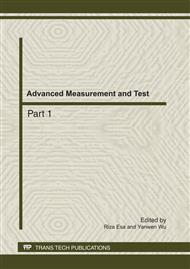[1]
Yamaguchi M, Mitsumori M, Kano Y. Noninvasively measuring blood glucose using saliva. IEEE Eng Med Biol Mag. vol. 17(1998), pp.59-63.
DOI: 10.1109/51.677170
Google Scholar
[2]
LIU Lin-lin, WANG Hua-zhong, ZUO Shi-you, et al. Enzymic determination of saliva glucose with use of 2, 4, 6-tribromo-3-hydroxybenzoic acid on biochemical analyzer[J]. Chongqing Medical Journal, vol. 35(2006), pp.1552-1556.
Google Scholar
[3]
Zhang Houyi. Detection Improvement And Implication Discussion of Saliva Glucose[J]. Qilu Journal of medical Laboratory Sciences, vol. 16(2005), pp.17-19.
Google Scholar
[4]
Jiang Liying, Ren Lijie, Chen Qinghua, et al. Glucose Biosensor of Anthropic Saliva[J]. Micronanoelectronic Technology, vol. 12(2010), pp.753-756.
Google Scholar
[5]
Liying Jiang, Hongmin Liu, Jian Liu, et al. A sensitive biosensor based on Os-complex mediator and glucose oxidase for low concentration glucose determination. Journal of Electroanalytical Chemistry, vol. 619–620(2008), p.11–16.
DOI: 10.1016/j.jelechem.2008.03.018
Google Scholar
[6]
W.Y. Chung, S.C. Cheng, C.C. Chuang, et al. A Wide Current Range Readout Circuit with Potentiostat for Amperometric Chemical Sensors, in IFMBE Proceedings, vol. 23(2009), pp.543-546.
DOI: 10.1007/978-3-540-92841-6_133
Google Scholar
[7]
W.Y. Chung, A.C. Paglinawan, Y.H. Wang, et al. A 600 W readout circuit with potentiostat for amperometric chemical sensors and glucose meter applications, in EDSSC Proc., IEEE Conference on Electron Devices and Solid-State Circuits, Taiwan, 2007, pp.1087-1090.
DOI: 10.1109/edssc.2007.4450317
Google Scholar
[8]
R.D. Beach, R.W. Conlan, M.C. Godwin, et al. Toward a miniature implantable in vivo telemetry monitoring system dynamically configurable as a potentiostat or galvanostat for two and three electrode biosensors, in IEEE Transactions on Instrumentation and Measurement, vol. 54(2005).
DOI: 10.1109/tim.2004.839757
Google Scholar
[9]
J. Zhang, N. Trombly, A. Mason, A low noise readout circuit for integrated electrochemical biosensor arrays, in ICSENS Proc., IEEE Conference on Sensors, vol. 1(2004), Vienna, Austria, pp.36-39.
DOI: 10.1109/icsens.2004.1426093
Google Scholar
[10]
Wang Lixin, Fu Chonggang. Study on Techniques for Current Measuring in the Picoampere Range[J]. Instrumentation Technology, (1999), pp.34-36.
Google Scholar
[11]
CHEN Guo-jie, CAO Hui. The design of high performance weak current integrated amplifier [J]. Nuclear Electronics & Detection Technology, vol. 25(2005), pp.243-245.
Google Scholar
[12]
Zhang Fang, Wang Jianhua, Liang Yuying. Simulation of circuit converting dedicate current to voltage based on PSPICE and EWB [J]. Microcomputer Information, vol. 22(2006), pp.272-274.
Google Scholar
[13]
Wang Yuee. Research on Measurement of Micro Current[D]. Preservation site:Xian University of Technology, (2005).
Google Scholar
[14]
Zheng Hongjun, Li Xin, Cao Yinjie, et al. Weak current signal detection theory and its application[J]. Video Engineering, (2002), pp.94-97.
Google Scholar


